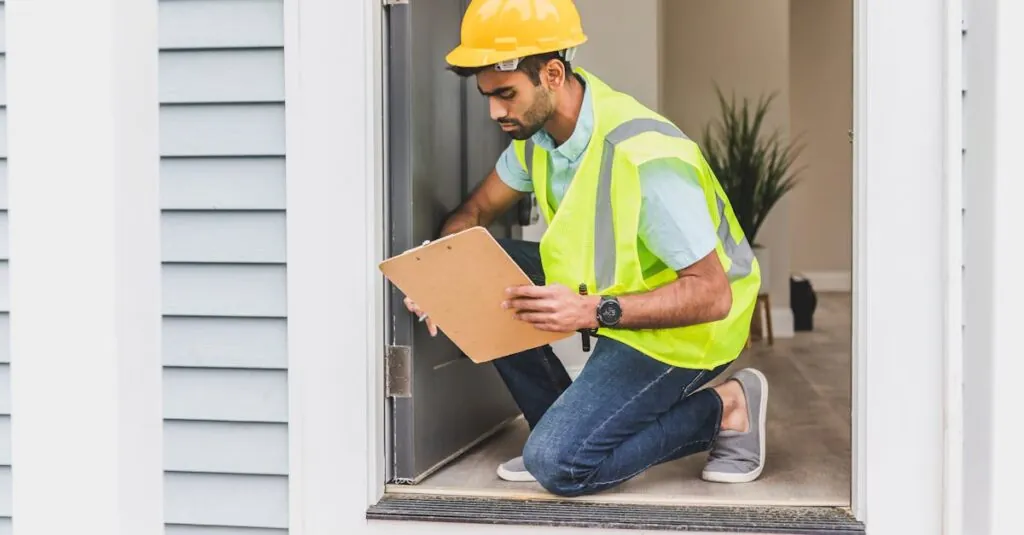Owning rental properties can feel a bit like juggling flaming swords while riding a unicycle. One wrong move and things could go up in smoke. That’s where a solid rental property maintenance checklist comes into play. It’s not just a list; it’s your trusty sidekick in the wild world of property management, ensuring everything runs smoothly and tenants stay happy.
Importance Of A Rental Property Maintenance Checklist
A rental property maintenance checklist streamlines property management tasks effectively. This tool helps property owners stay organized, ensuring no important maintenance tasks fall through the cracks. With regular inspections outlined in the checklist, maintenance issues can be identified and addressed promptly, reducing repair costs over time.
Effective tenant communication is enhanced through the use of a checklist. By proactively addressing maintenance needs, landlords foster positive relationships with tenants. Satisfied tenants are more likely to renew leases, leading to consistent rental income.
Additionally, a well-maintained property attracts quality tenants. Prospective renters are drawn to properties that demonstrate attention to upkeep and cleanliness. Details such as working appliances, functioning plumbing, and secure windows significantly influence tenant decision-making.
Compliance with local regulations is another critical aspect. Properties must meet various safety and maintenance standards. A checklist ensures landlords complete required inspections, reducing the risk of penalties or legal issues.
Cost efficiency is also a vital consideration. Regular maintenance can prevent more extensive and costly repairs in the future. By following a systematic approach through the checklist, property owners can budget effectively and allocate resources wisely.
Ultimately, using a rental property maintenance checklist solidifies property management practices. Structured maintenance guarantees that properties remain in optimal condition, leading to enhanced profitability and longevity in the rental market.
Key Components Of The Checklist
A comprehensive rental property maintenance checklist includes crucial elements that ensure properties remain in excellent condition. Focusing on regular inspections and seasonal maintenance tasks helps property owners effectively manage their responsibilities.
Regular Inspections
Regular inspections play a vital role in property management. These scheduled evaluations enable landlords to identify potential issues early, from plumbing leaks to electrical faults. Inspecting roofs, gutters, and HVAC systems ensures that all components function properly. Tenants can report problems promptly, fostering open communication. Documenting inspection results also assists in tracking maintenance history. Regular checks ultimately minimize long-term repair costs and enhance tenant satisfaction.
Seasonal Maintenance Tasks
Seasonal maintenance tasks are essential for protecting properties throughout the year. Spring often requires checking for water damage after winter, while summer focuses on air conditioning efficiency. In autumn, cleaning gutters and preparing heating systems for colder months become priorities. During winter, inspecting insulation ensures energy efficiency. Assigning these tasks seasonally aids in thorough upkeep and prevents last-minute rushes. Adhering to this routine improves overall property conditions and reduces emergency repairs.
Common Issues To Address
Property owners often encounter common issues that require attention to maintain optimal living conditions for tenants. Addressing these concerns promptly ensures smooth operations and tenant satisfaction.
Plumbing and Electrical Systems
Inspecting plumbing and electrical systems is essential for preventing major problems. Check for leaks in pipes and faucets, as these can lead to significant water damage. Additionally, testing circuit breakers and outlets helps identify any electrical faults. Regularly replacing worn-out fixtures, such as faucets or light switches, enhances safety and functionality. Managing these systems proactively reduces repair costs and encourages timely reporting by tenants, fostering a collaborative landlord-tenant relationship.
Heating and Cooling Systems
Heating and cooling systems play a vital role in tenant comfort. Schedule routine service for HVAC units to ensure efficient operation throughout the year. Change air filters regularly to maximize airflow and improve indoor air quality. Inspect ductwork for leaks, which can diminish system efficiency. Tenants appreciate when a property owner prioritizes their comfort by maintaining these systems, leading to higher tenant satisfaction and long-term lease retention. Addressing heating and cooling issues promptly can prevent costly emergency repairs during extreme weather conditions.
Tips For Effective Maintenance
Effective property maintenance relies on organization and attention to detail. Implementing strategies ensures smooth operations and tenant satisfaction.
Schedule Regular Updates
Establishing a maintenance schedule simplifies upkeep and prevents oversights. Property owners must plan seasonal inspections to identify potential issues before they escalate. After each detailed inspection, addressing necessary repairs leads to cost savings over time. Regular updates also enhance communication with tenants who appreciate proactive engagement. Communicating maintenance schedules fosters a sense of community and trust. Following a structured maintenance calendar ensures no critical tasks are missed, keeping properties in excellent condition.
Keep Detailed Records
Maintaining thorough records serves as a powerful tool for property management. Recording inspection results and maintenance activities allows for easy tracking of issues. These records help identify recurring problems, which can indicate deeper concerns needing attention. By documenting all communications with tenants regarding maintenance, landlords strengthen relationships and provide transparency. Utilizing digital tools or spreadsheets streamlines this process, ensuring easy access and organization of information. Well-maintained records contribute to effective budgeting, allowing property owners to allocate resources wisely and prioritize urgent repairs.
Conclusion
A rental property maintenance checklist is an invaluable asset for property owners. It not only enhances efficiency but also fosters positive relationships with tenants. By staying organized and proactive in addressing maintenance needs, landlords can significantly reduce unexpected repair costs and ensure tenant satisfaction.
Regular inspections and seasonal tasks outlined in the checklist help maintain properties in peak condition. This attention to detail attracts quality tenants and encourages lease renewals, ultimately bolstering rental income.
Adopting a systematic approach to property management through a comprehensive checklist lays a solid foundation for long-term success in the rental market.





